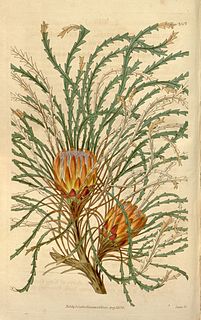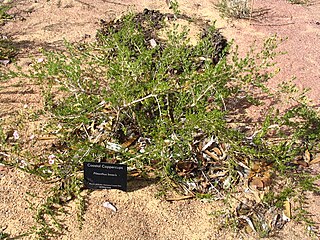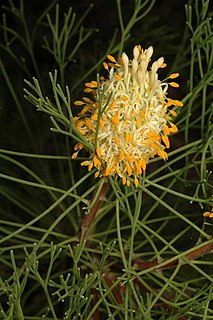
Banksia ashbyi, commonly known as Ashby's banksia, is a species of shrub or small tree that is endemic to Western Australia. It has smooth, grey bark, deeply serrated, hairy leaves and spikes of bright orange flowers.

Hakea myrtoides commonly known as myrtle hakea, is a shrub endemic to the woodlands of the Darling Range near Perth in Western Australia.

Banksia armata, commonly known as prickly dryandra, is a species of often sprawling shrub that is endemic to Western Australia. It has deeply serrated leaves with sharply pointed lobes and spikes of about 45 to 70 yellow flowers.
Banksia borealis is a species of sprawling shrub that is endemic to Western Australia. It has leaves with sharply pointed lobes on each side, between thirty and fifty flowers in a gold-coloured spike and egg-shaped fruit. There are two subspecies occurring in two disjunct areas.

Banksia tenuis is a species of shrub that is endemic to the southwest of Western Australia. It has pinnatifid, serrated or smooth-edges leaves, golden brown and cream-coloured flowers in heads of about fifty-five and glabrous, egg-shaped follicles.

Hakea orthorrhyncha, commonly known as bird beak hakea, is a shrub which is endemic to the Murchison River area of Western Australia.

Grevillea armigera, also known as prickly toothbrushes or thorny grevillea, is an erect shrub or tree which is endemic to the south-west of Western Australia. The species was formally described by Swiss botanist Carl Meissner in 1856.

Hakea prostrata, commonly known as harsh hakea, is a species of shrub that is endemic to the south-west of Western Australia. It is a low-lying shrub with prickly leaves and groups of white or cream-coloured flowers in late winter and early spring.

Hakea minyma, commonly known as watjula, is a species of shrub that is endemic to Australia. It has long, flat leaves, fragrant pink or white flower from late winter to spring.

Pileanthus is a genus of flowering plants in the family Myrtaceae, endemic to Western Australia. Collectively referred to by the common name coppercups, the eight currently recognised species are:
Synaphea polymorpha, commonly known as Albany synaphea, is a species of small shrub in the flowering plant family Proteaceae. It is endemic to Western Australia. The Noongar peoples know the plant as bindak.
Pileanthus bellus is a plant species of the family Myrtaceae endemic to Western Australia.

Pileanthus limacis, commonly known as coastal coppercups, is a plant species of the family Myrtaceae endemic to Western Australia.
Pileanthus peduncularis, commonly known as coppercups, is a plant species of the family Myrtaceae endemic to Western Australia.
Pileanthus rubronitidus is a plant species of the family Myrtaceae endemic to Western Australia.
Pileanthus septentrionalis is a plant species of the family Myrtaceae endemic to Western Australia.
Conospermum eatoniae, commonly known as blue lace, is a shrub endemic to Western Australia.

Petrophile fastigiata is a species of flowering plant in the family Proteaceae and is endemic to southwestern Western Australia. It is a shrub with pinnately-divided leaves with needle-shaped pinnae and sticky, oval heads of glabrous yellow to cream-coloured flowers.

Petrophile glauca is a species of flowering plant in the family Proteaceae and is endemic to southwestern Western Australia. It is a shrub with pinnately-divided, flattened, glaucous leaves and more or less spherical heads of hairy yellow to creamy-white flowers.

Isopogon scabriusculus is a species of flowering plant in the family Proteaceae and is endemic to southwestern Western Australia. It is a shrub with cylindrical, or narrow flat, sometimes forked leaves, and spherical to oval heads of pink or red flowers.













